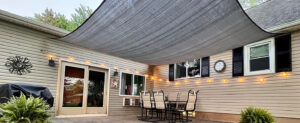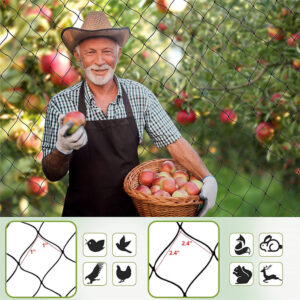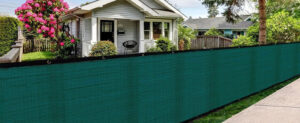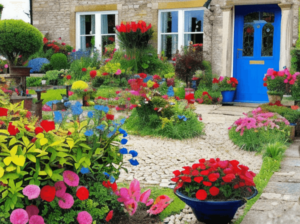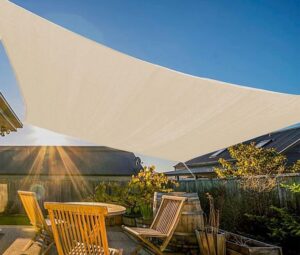Contact Us: [email protected] WhatsApp: +86-1365-3417-367
Introduction
Garden shade cloth is an essential tool for any gardener looking to protect their plants from the harsh effects of direct sunlight. Garden shade cloth, also known simply as shade cloth, is a breathable fabric used to shield plants from excessive sun, wind, and even pests. It plays a crucial role in creating an optimal growing environment by moderating temperature, controlling light exposure, and reducing the risk of sunscald and dehydration in sensitive plants.
The use of garden shade cloth can make a significant difference in the health and yield of your garden. Whether you are cultivating delicate flowers, fruits, or vegetables, shade cloth can help ensure that your plants thrive even during the peak of summer or in particularly sunny climates.
In this guide, we will explore everything you need to know about garden shade cloth, from the basics of what it is and the different types available, to detailed advice on selecting, installing, and maintaining shade cloth for your garden. With practical tips and expert advice, this guide will equip you with the knowledge to effectively use garden shade cloth to enhance the beauty and productivity of your garden space.
Understanding Garden Shade Cloths
What Are Garden Shade Cloths?
Garden shade cloth is a specially designed fabric made from synthetic materials like polyethylene or polyester. It’s crafted to withstand outdoor elements and is typically resistant to UV rays, ensuring longevity despite prolonged sun exposure. The primary function of a shade cloth is to reduce the intensity of direct sunlight that reaches the plants, which can help prevent issues like leaf burn, overheating, and excessive evaporation of soil moisture.
Different Types of Shade Cloth
Shade cloths come in various types, each suited to different gardening needs. Here are the main types you’ll encounter:
- Knitted Shade Cloths: These are made from lightweight polyethylene threads, knitted together. They are highly durable and resist fraying and tearing. Knitted shade cloths are ideal for most gardening applications as they provide good air circulation and are easy to handle.
- Woven Shade Cloths: Woven shade cloths are heavier and more suitable for applications where stronger protection is needed. They can be more challenging to install due to their weight but offer excellent durability and sun protection.
- Color Variations: Shade cloths are available in colors such as black, white, green, and aluminet. Black shade cloths are the most common and provide the best protection from UV rays, while white or aluminet cloths reflect heat better and are ideal for cooler, shaded environments.
Here is a simple table summarizing the properties of each type:
| Type of Shade Cloth | Material | Ideal Use |
|---|---|---|
| Knitted | Polyethylene | General garden use, easy handling |
| Woven | Polyester | High durability, strong sun protection |
| Aluminet | Reflective | Heat-sensitive areas, cooler climates |
The Science Behind Shade Cloth and Plant Growth
Understanding how shade cloth impacts plant growth involves recognizing its role in manipulating the microclimate around your plants. Here are key factors influenced by shade cloth:
- Temperature Control: By blocking out a significant percentage of sunlight, shade cloths help keep the area beneath them cooler, which can be crucial for heat-sensitive plants during the summer.
- Light Diffusion: Shade cloths scatter sunlight, reducing the intensity while still allowing enough light for photosynthesis. This diffusion helps prevent the harsh shadows and stark contrasts that direct sunlight can create, promoting more uniform and gentle plant growth.
- Moisture Retention: By reducing evaporation rates from soil and plant leaves, shade cloths help maintain a more consistent moisture level, crucial for many plants’ health and growth.
Shade cloth not only protects plants from excessive sunlight but also enables gardeners to extend their growing seasons by creating more favorable environmental conditions earlier in the spring and later into the fall.
Selecting the Right Garden Shade Cloth
Choosing the right garden shade cloth involves understanding the specific needs of your garden and the various factors that affect plant growth in your area. Here’s how to make the best choice:
Factors to Consider When Choosing Shade Cloth
- Light Transmission Needs: Depending on what you are growing, the amount of light your plants require will vary. Vegetables and flowering plants generally need more light, while leafy greens might thrive under denser shade. The percentage on the shade cloth indicates how much light it blocks; for instance, a 30% shade cloth blocks 30% of the light, making it suitable for plants that need a lot of sunlight.
- Durability and Weather Resistance: Consider the environmental conditions in your area. If you experience high winds or heavy rainfall, you’ll need a robust shade cloth, like a woven type, that can withstand these elements.
- Local Climate: The climate of your area plays a significant role in selecting the shade percentage. In hotter, sunnier climates, a higher shade percentage might be necessary to protect plants effectively.
Shade Cloth Density and Its Uses
To help you decide on the density of the shade cloth, here’s a guide on how different densities cater to various plant types:
- 30% Shade Cloth: Best for protecting vegetables and fruits that require a lot of sunlight.
- 50% Shade Cloth: Ideal for partial-shade plants, such as some flowering plants and young saplings that need protection from intense midday sun.
- 70% Shade Cloth: Suitable for shade-loving plants or to protect plants from overheating in very hot climates.
Table: Recommended Shade Cloth Density by Plant Type
| Plant Type | Recommended Shade Cloth Density |
|---|---|
| Vegetables and Fruits | 30% |
| Flowering Plants | 50% |
| Shade-loving Plants | 70% |
When selecting a shade cloth, it’s also important to consider the installation space and the aesthetic you want to maintain in your garden. For example, lighter colors like white or aluminet can blend more seamlessly into garden spaces without making the area look too dark or closed off.
Practical Applications of Shade Cloth in the Garden
Installing and utilizing garden shade cloth effectively can transform your garden into a more productive and sustainable space. Here’s how to apply shade cloth for maximum benefit:
Installation Tips for Maximum Effectiveness
1. Assess the Area: Before installation, evaluate where your garden receives the most sunlight. This assessment helps in deciding the optimal placement for the shade cloth to provide adequate protection throughout the day.
2. Tools and Materials Needed:
- Measuring tape to determine the required size of the shade cloth.
- Suitable fasteners such as zip ties, ropes, or garden wire.
- Support structure, which could be wooden frames, metal poles, or existing structures like fences or walls.
- Scissors or a sharp knife for cutting the shade cloth to size.
3. Installation Steps:
- Step 1: Measure the area and cut the shade cloth to fit, leaving a little extra on each side for secure attachment.
- Step 2: Attach the shade cloth to the support structure, ensuring it is taut to avoid sagging. Use the fasteners at regular intervals to keep it secure.
- Step 3: Adjust the cloth as needed throughout the season to optimize sun protection as the sun’s position changes.
DIY Garden Shade Cloth Structures
For gardeners who enjoy DIY projects, creating your own shade cloth structure can be a rewarding task. Here’s a simple guide to building a basic frame:
1. Materials Needed:
- Four wooden posts or metal poles.
- Screws or nails for assembling the frame.
- Your chosen shade cloth.
2. Construction Steps:
- Step 1: Install the posts at each corner of the area you want to shade. Ensure they are deeply embedded into the ground for stability.
- Step 2: Create a horizontal support by attaching a beam across the top of the posts.
- Step 3: Drape the shade cloth over the top and secure it to the frame with fasteners, ensuring it covers the entire area without gaps.
3. Creative Integration:
Consider integrating the shade structure with your garden’s design by using decorative posts or painting the structure to match your garden’s theme. Adding climbing plants around the posts can also create a more natural, integrated look.
Creative Ideas for Shade Cloth in Garden Design
- Vertical Gardens: Use shade cloth as a backdrop for vertical gardens to protect sensitive plants from too much sun.
- Pathway Covers: Create shaded pathways in your garden by installing shade cloth overhead, making the garden more enjoyable to walk through on sunny days.
- Seasonal Adjustments: Design your shade cloth setup to be adjustable or removable, accommodating different plants’ needs as seasons change.
Maintenance and Care for Shade Cloth
Proper maintenance and care of your garden shade cloth are essential for maximizing its lifespan and effectiveness. Here are key tips and best practices for keeping your shade cloth in top condition:
Cleaning Your Shade Cloth
1. Routine Cleaning:
- Frequency: Regularly brush off debris and dust to prevent accumulation, which can reduce the cloth’s permeability and effectiveness.
- Method: Use a soft brush or cloth to gently remove surface dirt. For more thorough cleaning, hose down the shade cloth with water.
2. Deep Cleaning:
- Step 1: Dilute a small amount of mild detergent in water.
- Step 2: Apply the soapy solution to the shade cloth using a sponge or soft cloth.
- Step 3: Gently scrub to remove stubborn stains or buildup.
- Step 4: Rinse thoroughly with clean water to remove all soap residues.
3. Important Considerations:
Avoid using harsh chemicals or abrasive tools that can damage the fabric.
Ensure the shade cloth is completely dry before storing to prevent mold and mildew growth.
Storing Your Shade Cloth
When not in use, such as during the off-season, proper storage is crucial to prevent damage:
- Preparation: Clean the shade cloth thoroughly and ensure it’s dry.
- Folding: Neatly fold the shade cloth to prevent creases or damage.
- Storage Location: Store in a cool, dry place away from direct sunlight and sharp objects that could puncture or tear the fabric.
- Container: Use a breathable fabric bag or a plastic bin with a lid to protect from dust and pests.
Inspection and Repair
- Regular Inspection:
Periodically check for signs of wear, such as fraying edges or holes. Early detection of damage can save you from needing a complete replacement.
- Repair Techniques:
Minor Tears: Use UV-resistant thread or a shade cloth repair tape to mend small tears.
Larger Damage: For more significant damage, patch the area with a piece of matching shade cloth, securing it with stitching or heavy-duty adhesive designed for outdoor use.
By following these maintenance and care tips, you can ensure that your garden shade cloth remains functional and effective for many growing seasons. Regular upkeep not only preserves the material but also ensures that your garden continues to benefit from the optimal conditions that shade cloth provides.
Troubleshooting Common Shade Cloth Issues
Even with proper installation and maintenance, you might encounter some issues with your garden shade cloth. Here are some common problems and how to address them effectively:
Handling Tears and Damage
Minor Tears:
- Cause: General wear and tear, or physical damage from garden tools or branches.
Solution: For small tears, clean the area around the tear, dry it thoroughly, and apply shade cloth repair tape or use UV-resistant thread to sew the tear closed. This will prevent the tear from expanding and compromising the structure.
Major Damage:
- Cause: Severe weather conditions like strong winds or heavy snowfall, or accidental damage during handling.
Solution: If the damage is extensive, it may be more practical to replace the affected section of the shade cloth. Cut out the damaged area, and sew a new piece of shade cloth into place, ensuring that it’s securely attached and blends with the rest of the installation.
Adjusting Shade Cloth Positioning
- Problem: Inadequate shade coverage or excessive shading leading to poor plant growth.
Solution: Regularly evaluate the position of your shade cloth, especially as seasons change. Adjust the angle or position to optimize light exposure. If the cloth is fixed, consider using a sliding mechanism or removable sections to vary the shading as needed.
Preventive Measures and Regular Checks
- Regular Inspections: Schedule monthly inspections to check for any visible signs of wear or damage.
- Seasonal Adjustments: Make adjustments to the setup to accommodate changes in weather, such as more substantial anchoring before the windy season.
- Proactive Maintenance: Clean and repair your shade cloth regularly to maintain its integrity and functionality.
By proactively managing these common issues, you can extend the life of your garden shade cloth and ensure it continues to provide the best possible conditions for your plants.
Conclusion
Garden shade cloth is an indispensable tool for any gardener seeking to protect and nurture their plants. Its benefits extend beyond just shielding flora from harsh sunlight, it also helps in temperature regulation, moisture retention, and can even enhance plant growth by creating a more favorable microenvironment. Whether you are dealing with delicate flowering plants, vegetables, or ornamental gardens, the right shade cloth can make a significant difference in your gardening success.
From understanding the various types of shade cloths and selecting the appropriate one for your needs to installing it correctly and maintaining its condition, each step is crucial in maximizing the potential of your garden. By following the guidelines and advice provided in this guide, you can effectively integrate shade cloth into your garden setup, ensuring your plants thrive in various conditions.
Are you ready to take your gardening to the next level with the help of a garden shade cloth? We encourage you to share your experiences and successes with shade cloth in the comments below. If you have any questions or need further advice, don’t hesitate to ask. Let’s continue to grow our gardening community by sharing knowledge and supporting each other in our horticultural endeavors.
Frequently Asked Questions (FAQs)
Let’s address some common questions about garden shade cloth :
A: For most vegetable gardens, a shade cloth with 30% to 50% shade rate is ideal. This range provides ample sunlight for photosynthesis while protecting plants from the harshest rays of the sun, particularly useful for sun-sensitive vegetables like lettuce and spinach.
A: Yes, shade cloth can help extend the growing season by moderating temperature extremes, both hot and cold. By using shade cloth to protect plants from early or late frosts and by cooling the garden environment during peak summer, gardeners can start planting earlier in the spring and extend the growing period into the fall.
A: The lifespan of shade cloth depends on the material and environmental conditions, but generally, it should be inspected annually for signs of wear and tear. High-quality shade cloths can last between 5 to 10 years if maintained properly.
A: Yes, different colors of shade cloth can affect the amount of light and heat that is transmitted. For example, black shade cloths typically absorb and block more sunlight, making them suitable for very sunny climates, whereas white or reflective shade cloths (like aluminet) tend to reflect sunlight, helping keep the area underneath cooler and are better for cooler or shaded environments.
A: To secure shade cloth in windy conditions, ensure it is tightly fastened to a sturdy frame or structure. Use durable fasteners like zip ties or heavy-duty clips at regular intervals along the edges and across the fabric. Consider reinforcing the corners and edges with extra fastening points, and regularly check these attachments throughout the season to adjust the tension and repair any loose areas.

